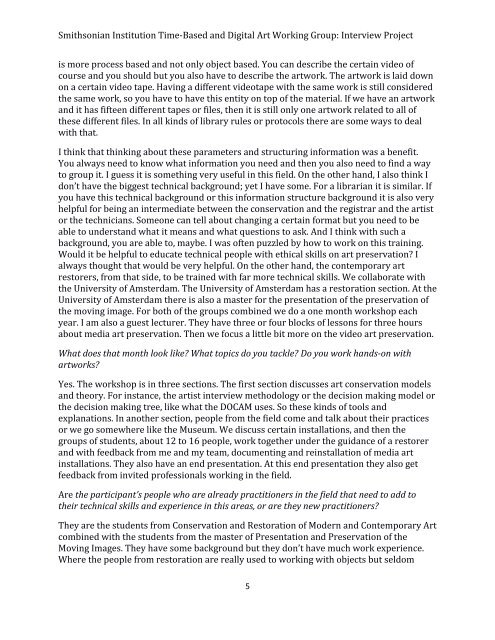Gaby Wijers - Smithsonian Institution
Gaby Wijers - Smithsonian Institution
Gaby Wijers - Smithsonian Institution
You also want an ePaper? Increase the reach of your titles
YUMPU automatically turns print PDFs into web optimized ePapers that Google loves.
<strong>Smithsonian</strong> <strong>Institution</strong> Time-Based and Digital Art Working Group: Interview Project<br />
is more process based and not only object based. You can describe the certain video of<br />
course and you should but you also have to describe the artwork. The artwork is laid down<br />
on a certain video tape. Having a different videotape with the same work is still considered<br />
the same work, so you have to have this entity on top of the material. If we have an artwork<br />
and it has fifteen different tapes or files, then it is still only one artwork related to all of<br />
these different files. In all kinds of library rules or protocols there are some ways to deal<br />
with that.<br />
I think that thinking about these parameters and structuring information was a benefit.<br />
You always need to know what information you need and then you also need to find a way<br />
to group it. I guess it is something very useful in this field. On the other hand, I also think I<br />
don’t have the biggest technical background; yet I have some. For a librarian it is similar. If<br />
you have this technical background or this information structure background it is also very<br />
helpful for being an intermediate between the conservation and the registrar and the artist<br />
or the technicians. Someone can tell about changing a certain format but you need to be<br />
able to understand what it means and what questions to ask. And I think with such a<br />
background, you are able to, maybe. I was often puzzled by how to work on this training.<br />
Would it be helpful to educate technical people with ethical skills on art preservation? I<br />
always thought that would be very helpful. On the other hand, the contemporary art<br />
restorers, from that side, to be trained with far more technical skills. We collaborate with<br />
the University of Amsterdam. The University of Amsterdam has a restoration section. At the<br />
University of Amsterdam there is also a master for the presentation of the preservation of<br />
the moving image. For both of the groups combined we do a one month workshop each<br />
year. I am also a guest lecturer. They have three or four blocks of lessons for three hours<br />
about media art preservation. Then we focus a little bit more on the video art preservation.<br />
What does that month look like? What topics do you tackle? Do you work hands-on with<br />
artworks?<br />
Yes. The workshop is in three sections. The first section discusses art conservation models<br />
and theory. For instance, the artist interview methodology or the decision making model or<br />
the decision making tree, like what the DOCAM uses. So these kinds of tools and<br />
explanations. In another section, people from the field come and talk about their practices<br />
or we go somewhere like the Museum. We discuss certain installations, and then the<br />
groups of students, about 12 to 16 people, work together under the guidance of a restorer<br />
and with feedback from me and my team, documenting and reinstallation of media art<br />
installations. They also have an end presentation. At this end presentation they also get<br />
feedback from invited professionals working in the field.<br />
Are the participant’s people who are already practitioners in the field that need to add to<br />
their technical skills and experience in this areas, or are they new practitioners?<br />
They are the students from Conservation and Restoration of Modern and Contemporary Art<br />
combined with the students from the master of Presentation and Preservation of the<br />
Moving Images. They have some background but they don’t have much work experience.<br />
Where the people from restoration are really used to working with objects but seldom<br />
5
















